
Fundamentals
In the gentle, expansive landscape of textured hair care, a concept often whispers from the deepest wells of wisdom ❉ Restorative Slumber. This is not merely about closing one’s eyes for a few hours each night; rather, it speaks to a profound, intentional period of repose, a sacred interlude when the hair and scalp are given over to healing, renewal, and fortification. Roothea recognizes this nightly ritual as a cornerstone of vitality for curls, coils, and waves, particularly those of Black and mixed heritage, which carry unique needs and historical considerations.
The basic meaning of Restorative Slumber for textured hair unfolds as a dedicated time for the hair to recuperate from daily environmental stressors and mechanical manipulation. It involves creating an optimal environment that minimizes friction, preserves moisture, and supports the hair’s intrinsic repair mechanisms. This deliberate nightly practice is about more than just maintaining a hairstyle; it centers on nurturing the very structural integrity and overall health of each strand, from root to tip.
Restorative Slumber for textured hair signifies a purposeful nightly period of deep care, allowing strands to heal, retain moisture, and strengthen against daily wear.

The Quiet Work of Renewal
During the hours of genuine rest, our bodies orchestrate a complex ballet of biological functions, many of which directly influence the health and appearance of our hair. Cellular repair processes accelerate, growth hormones are released, and vital nutrients are delivered more efficiently to hair follicles. For textured hair, this nocturnal period offers a precious opportunity to counteract the day’s challenges, which often include moisture loss and potential breakage.
The hair’s natural growth cycle, encompassing phases of growth, transition, and rest, finds a crucial ally in consistent, quality sleep. Disrupted sleep patterns can interfere with these cycles, potentially accelerating the resting phase and leading to increased shedding. Therefore, cultivating a true Restorative Slumber means aligning our nightly habits with our hair’s biological rhythms, fostering an environment where follicles can thrive and strands can achieve their full potential.
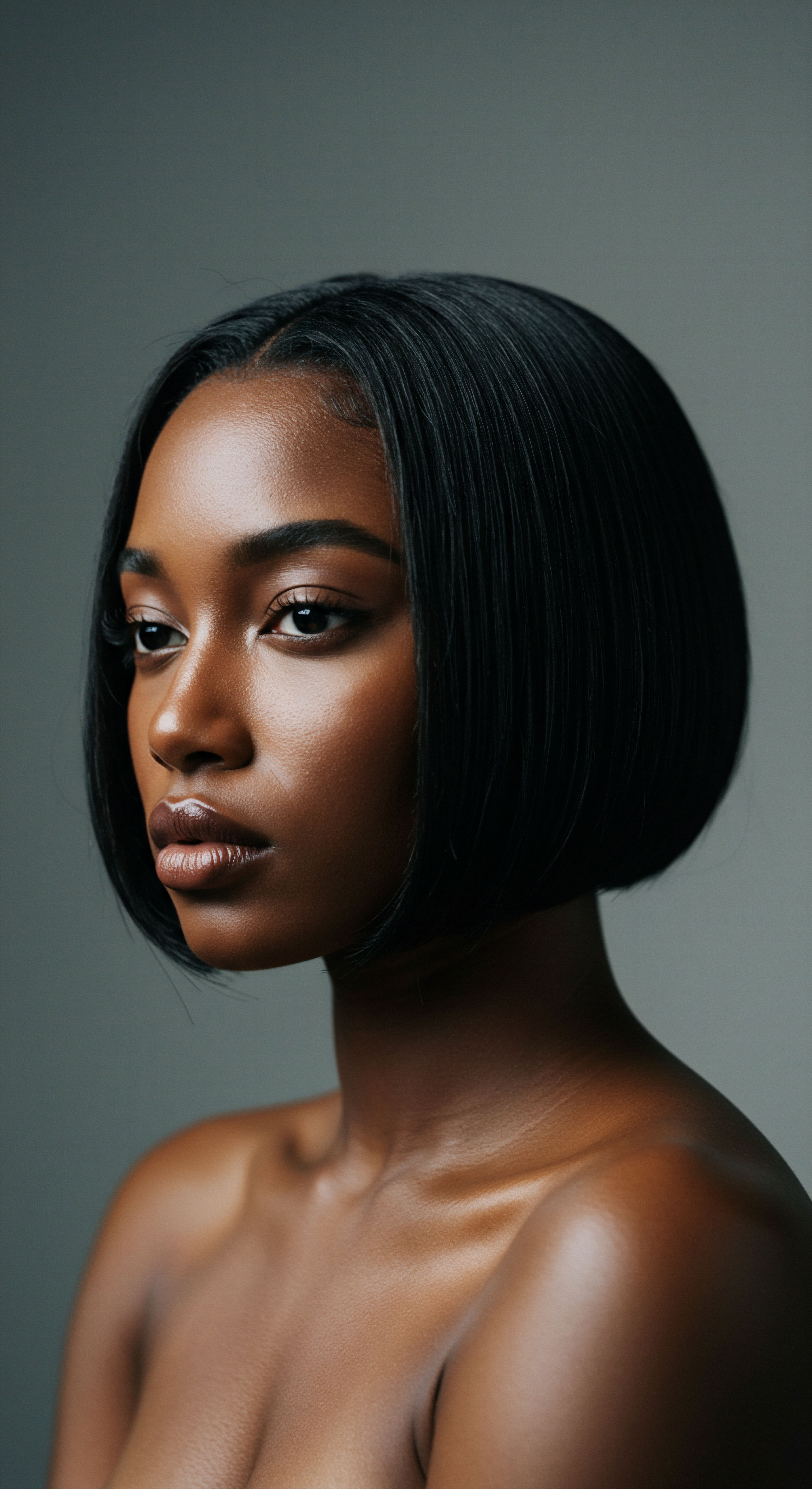
Why Textured Hair Seeks This Respite
Textured hair, with its distinctive curl patterns—from loose waves to tight coils—possesses a beauty unlike any other, yet these very characteristics present specific vulnerabilities. The natural bends and twists along the hair shaft make it inherently more prone to dryness, as the scalp’s natural oils, known as sebum, struggle to travel down the entire length of the strand. This structural reality makes moisture retention a continuous, dedicated pursuit for individuals with textured hair.
Beyond dryness, textured hair can experience increased friction and tangling, especially during sleep when movement can cause strands to rub against abrasive surfaces. This mechanical stress can lift the hair’s delicate cuticle layers, leading to frizz, split ends, and breakage. Understanding the significance of Restorative Slumber becomes a foundational step in mitigating these concerns, allowing the hair to maintain its natural resilience and exquisite definition.
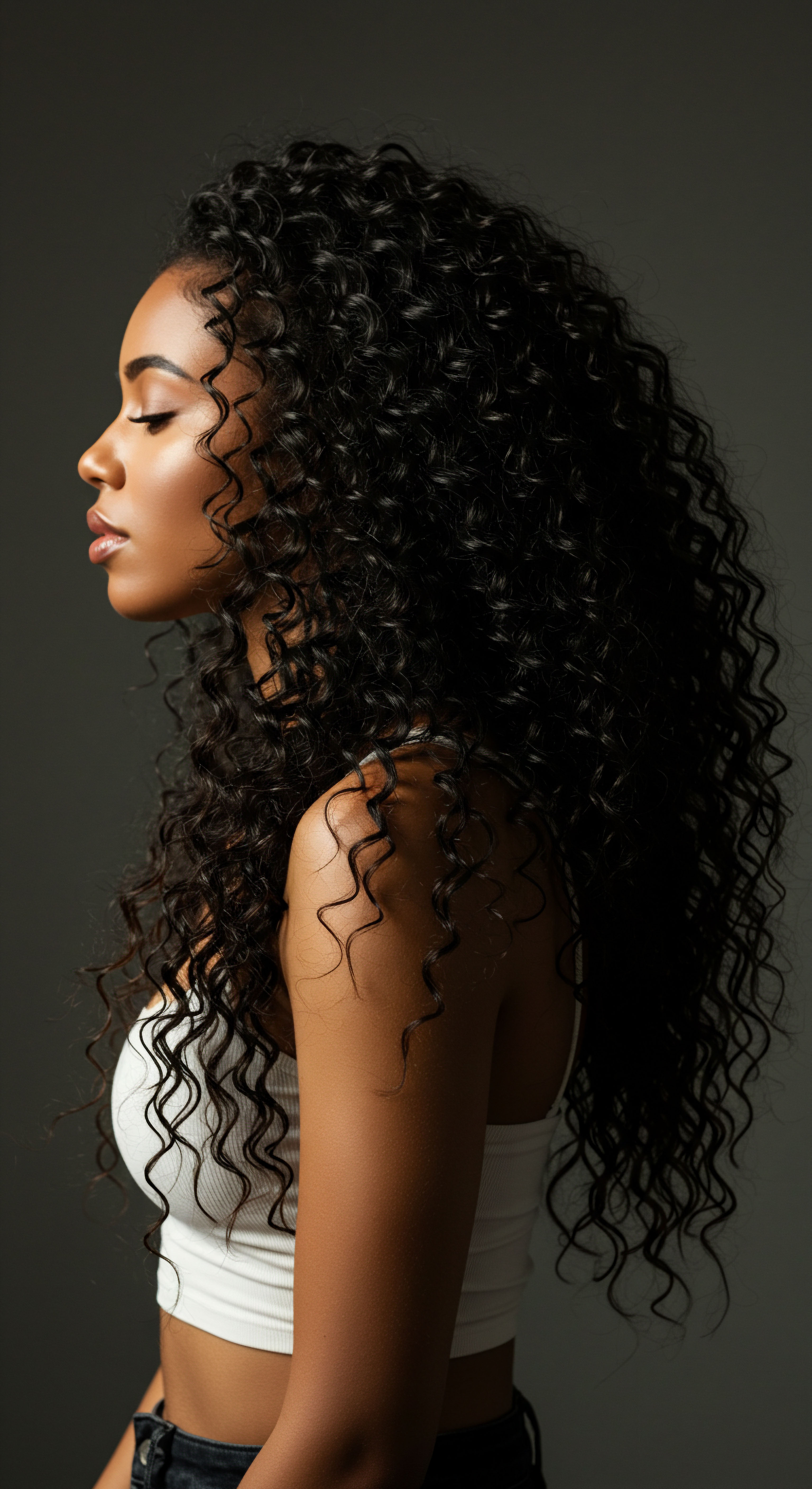
Intermediate
Moving beyond the foundational understanding, the intermediate meaning of Restorative Slumber delves into its practical application and the deliberate practices that elevate mere sleep into a truly regenerative experience for textured hair. This deeper exploration acknowledges the common challenges faced by those with curls and coils, positioning the nightly routine as a proactive strategy for maintaining vibrancy and mitigating damage.
This concept finds its expression not in a single act, but in a symphony of mindful preparations that transform the sleeping hours into a period of active care. It’s a strategic approach to hair wellness, recognizing that the hair’s state upon waking is largely a reflection of the conditions it experienced during the night. The interpretation of Restorative Slumber at this level involves understanding how various elements, from chosen fabrics to specific styling techniques, contribute to the hair’s overnight well-being.
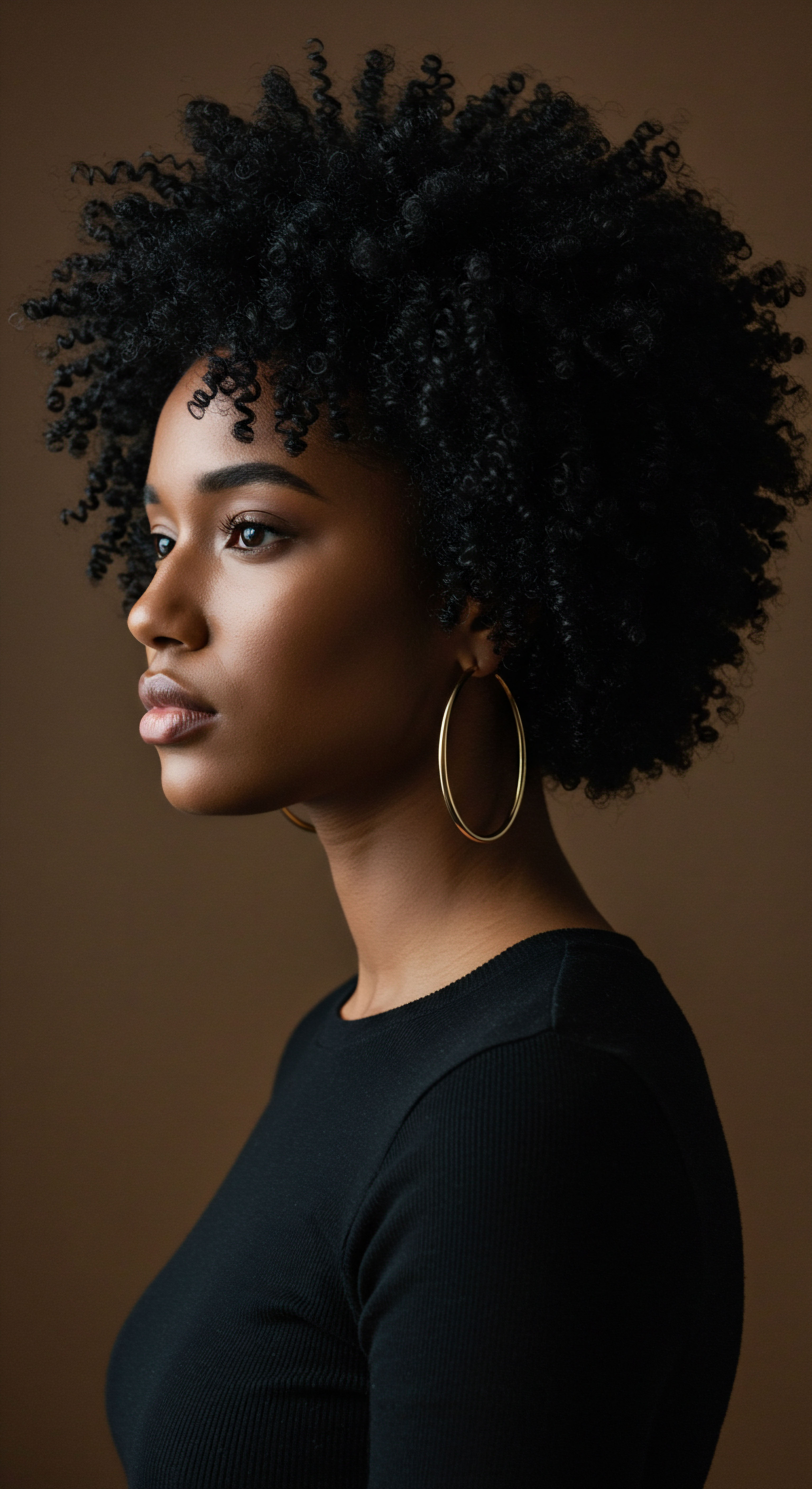
The Rituals of Nightly Preservation
For individuals with textured hair, a comprehensive nightly regimen is not merely an optional indulgence; it represents a protective shield against the very forces that can compromise hair health. The primary objective centers on two key pillars ❉ moisture retention and minimizing mechanical friction. These elements work in concert to ensure that hair remains hydrated, defined, and less susceptible to breakage during the hours of repose.
A consistent routine might begin with ensuring the hair is adequately moisturized before bed. Applying a lightweight leave-in conditioner or a nourishing hair oil helps to seal in moisture, providing a protective barrier against environmental dryness and absorption by bedding materials. This deliberate hydration prepares the hair for the unique demands of the sleeping process.

Choosing the Right Sanctuary
The surface upon which hair rests during the night plays a pivotal role in its condition upon waking. Cotton pillowcases, despite their widespread use, can be particularly detrimental to textured hair. Their absorbent fibers readily wick away moisture from the hair, leaving it dry and brittle. Moreover, the rough texture of cotton creates significant friction as hair moves during sleep, leading to tangles, frizz, and ultimately, breakage.
The significance of selecting alternative materials, such as silk or satin, cannot be overstated in the pursuit of Restorative Slumber. These smooth fabrics drastically reduce friction, allowing hair to glide effortlessly across the surface, thereby preserving its natural curl pattern and minimizing damage. They also absorb less moisture, ensuring that the hair’s natural oils and applied products remain where they belong ❉ on the strands themselves.
Alternatively, incorporating a silk or satin bonnet or scarf provides an equally effective, and often more secure, method of protection. These coverings act as a direct barrier between the hair and potentially damaging surfaces, keeping styles intact and moisture locked within. This practice, deeply rooted in the heritage of Black and mixed hair care, extends beyond mere aesthetics; it is a profound act of self-preservation and a testament to generations of wisdom.
Embracing silk or satin for nighttime protection forms a vital part of Restorative Slumber, significantly reducing friction and safeguarding precious moisture.
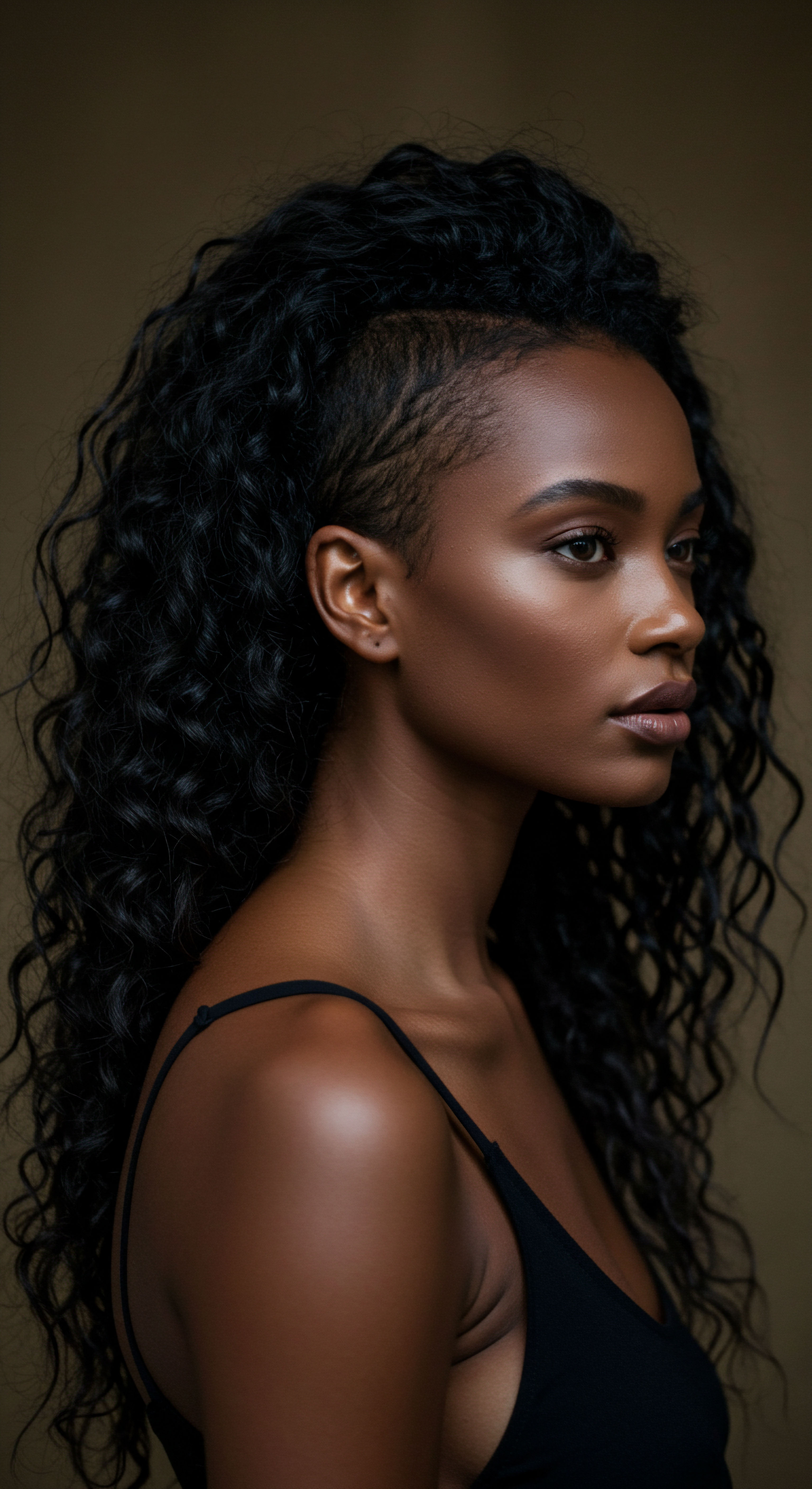
Styling for Serene Strands
Beyond material choices, specific hairstyles adopted before sleep can further enhance the benefits of Restorative Slumber. These are often referred to as “protective styles” and are designed to minimize manipulation, prevent tangling, and maintain curl definition.
- Pineapple Method ❉ This involves gathering all hair to the very top of the head, securing it loosely with a silk scrunchie or hair tie. This position keeps the majority of the hair elevated and off the pillow, reducing compression and preserving volume.
- Loose Braids or Twists ❉ Dividing hair into one or more loose braids or two-strand twists can prevent tangling and breakage by keeping strands organized. This also allows for gentle stretching of the hair, which can result in elongated, defined curls upon waking.
- Bantu Knots ❉ For those seeking more defined curls or waves without heat, Bantu knots offer a method of setting hair while it rests, providing a protective measure against friction and moisture loss.
Each of these approaches contributes to the overall goal of Restorative Slumber by creating a stable, protected environment for the hair, allowing it to undergo its natural reparative processes undisturbed. The intentionality behind these practices transforms a simple nightly routine into a meaningful act of hair preservation.

Advanced
The advanced explication of Restorative Slumber transcends surface-level care, delving into its profound significance as a multifaceted phenomenon influencing the very cellular and structural integrity of textured hair. This comprehensive interpretation acknowledges the interplay of biological mechanisms, cultural heritage, and the nuanced science of hair fiber dynamics, particularly for Black and mixed-race hair. It represents a deep, expert-driven insight into how optimized nocturnal conditions contribute to long-term hair resilience and overall scalp health, moving beyond mere aesthetic benefits to foundational wellness.
The meaning of Restorative Slumber, at this elevated plane, encompasses a holistic understanding of the hair’s micro-environment during periods of extended inactivity. It is a strategic intervention, a conscious commitment to counteracting the unique vulnerabilities inherent to the helical geometry of textured hair, which, as research reveals, faces distinct challenges in maintaining structural fortitude and hydration. This profound appreciation informs not only personal care but also the development of products and practices designed for truly regenerative outcomes.
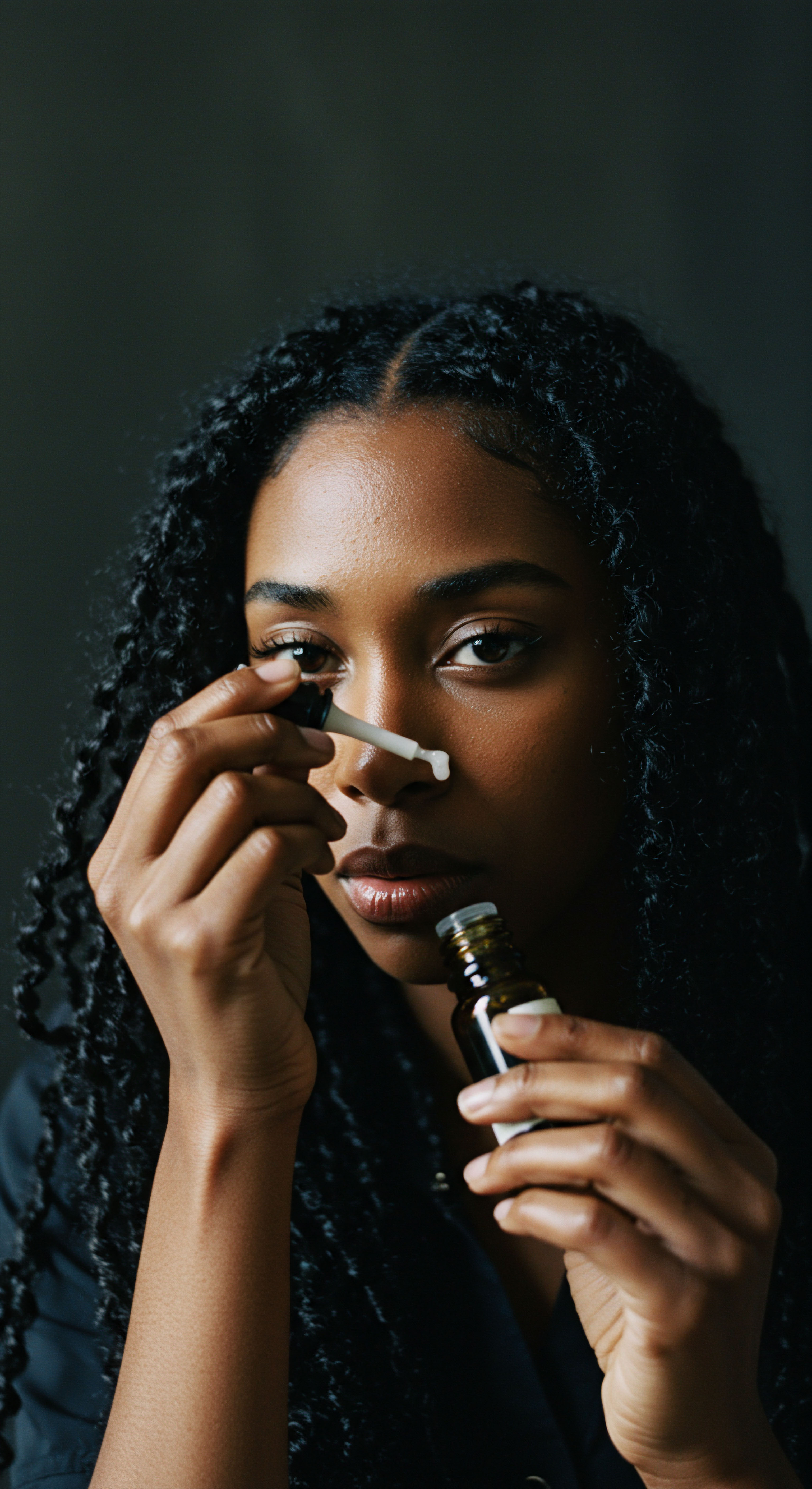
The Biological Symphony of Nocturnal Repair
During deep sleep, the body initiates a complex cascade of physiological processes essential for cellular regeneration and systemic balance. For hair, this translates into heightened metabolic activity within the dermal papilla, the living part of the hair follicle that controls hair growth and development. Hormones such as human growth hormone and melatonin, crucial for cellular proliferation and antioxidant defense, reach their peak production, directly supporting the anagen (growth) phase of the hair cycle. Adequate circulation, too, is optimized, ensuring a steady delivery of oxygen and vital nutrients to the follicular units, which are the very factories of hair production.
Conversely, a deficit in Restorative Slumber can lead to a physiological imbalance. Chronic sleep deprivation elevates cortisol levels, a stress hormone known to prematurely usher hair follicles into the telogen (resting) phase, resulting in increased shedding, a condition known as telogen effluvium. This understanding underpins the profound impact of sleep quality on hair density and growth rates, making the concept of Restorative Slumber a critical, rather than ancillary, component of hair health.
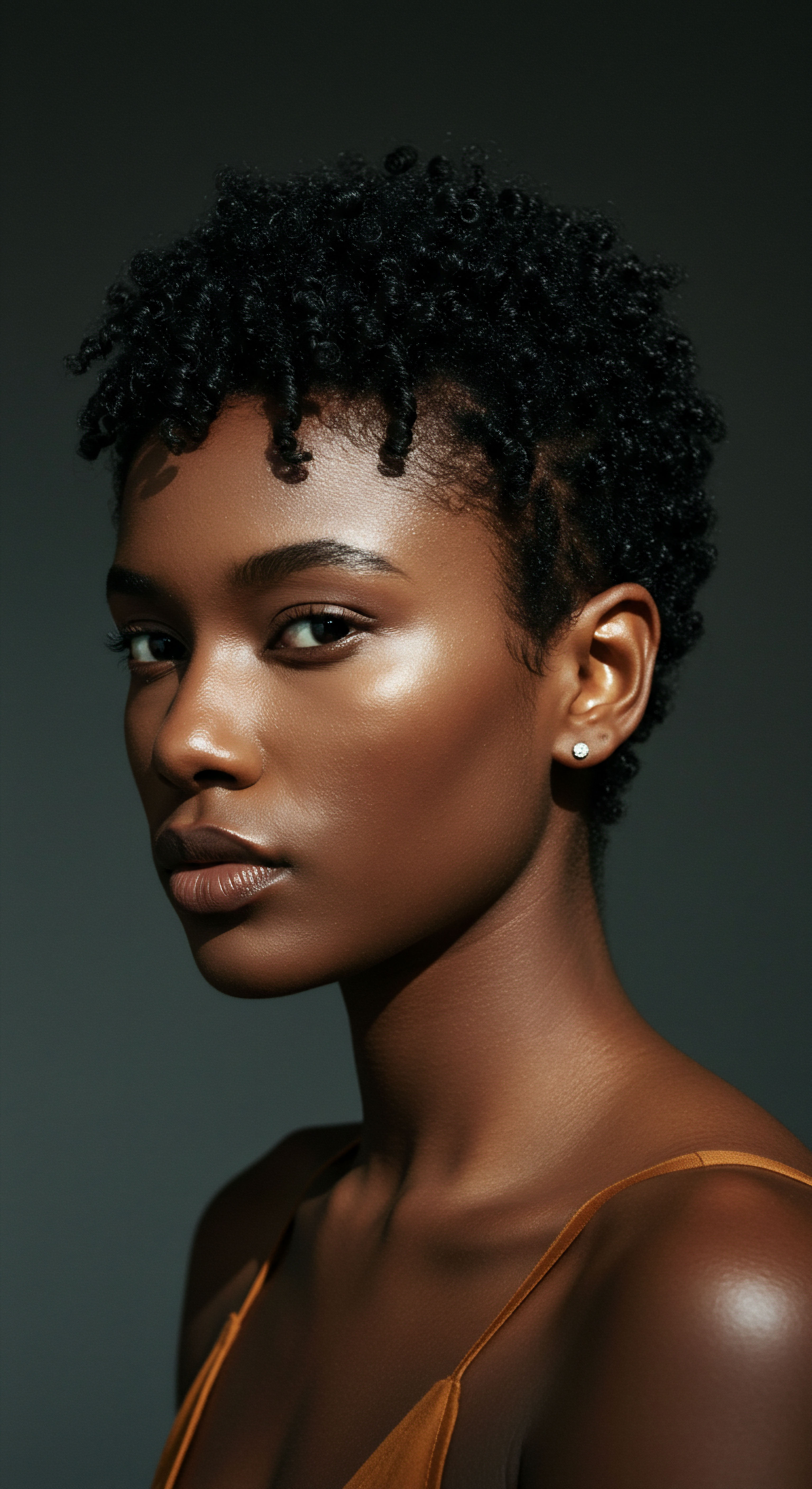
Unraveling the Dynamics of Friction and Fragility
The inherent structural characteristics of textured hair render it particularly susceptible to mechanical stress, a factor significantly amplified during sleep. Unlike straight hair, which allows sebum to lubricate the entire shaft with relative ease, the twists and turns of curly and coily strands create natural obstacles for oil distribution, leading to localized dryness. This dryness, paired with the typically raised cuticle layers of textured hair, creates an environment where friction can inflict considerable damage.
A revealing aspect of hair fiber mechanics, often overlooked in general hair care discussions, highlights the unique vulnerability of textured hair. A large-population study, employing the eight-point Loussouarn scale to quantify curliness, demonstrated that Hair’s Break Stress Decreases with an Increase in Curliness. This scientific finding suggests that the very curls and twists that give textured hair its distinctive beauty simultaneously create concentrations of stress and local points of weakness when the hair is subjected to stretching or friction, thereby predisposing it to fracture formation. This is a profound data point, underscoring that the battle against breakage for textured hair is not merely about rough handling, but about managing an intrinsic structural predisposition.
This inherent fragility is compounded by the nocturnal environment. The continuous rubbing against common pillowcase materials, such as cotton, acts as an abrasive force, lifting and chipping the hair’s protective cuticle scales. This damage exposes the inner cortex, leading to moisture loss, increased tangling, and visible frizz. The implication is clear ❉ Restorative Slumber necessitates a conscious intervention to mitigate these destructive frictional forces.
Consider the stark contrast presented by alternative materials. The smooth surface of silk, for instance, has been scientifically shown to reduce hair friction by up to 43% compared to cotton. This significant reduction is not a mere luxury; it translates directly into preserved cuticle integrity, diminished tangling, and a notable decrease in mechanical breakage, which is especially critical for hair types already predisposed to fracture.
| Material Cotton |
| Friction Level High |
| Moisture Absorption High (wicks moisture) |
| Impact on Hair Cuticle Lifts, chips, abrades |
| Common Outcome for Textured Hair Dryness, frizz, tangles, breakage |
| Material Silk/Satin |
| Friction Level Low |
| Moisture Absorption Low (retains moisture) |
| Impact on Hair Cuticle Smooths, protects |
| Common Outcome for Textured Hair Moisture retention, reduced frizz, preserved definition, less breakage |
| Material Choosing silk or satin is a strategic decision for preserving the delicate structure of textured hair during sleep. |
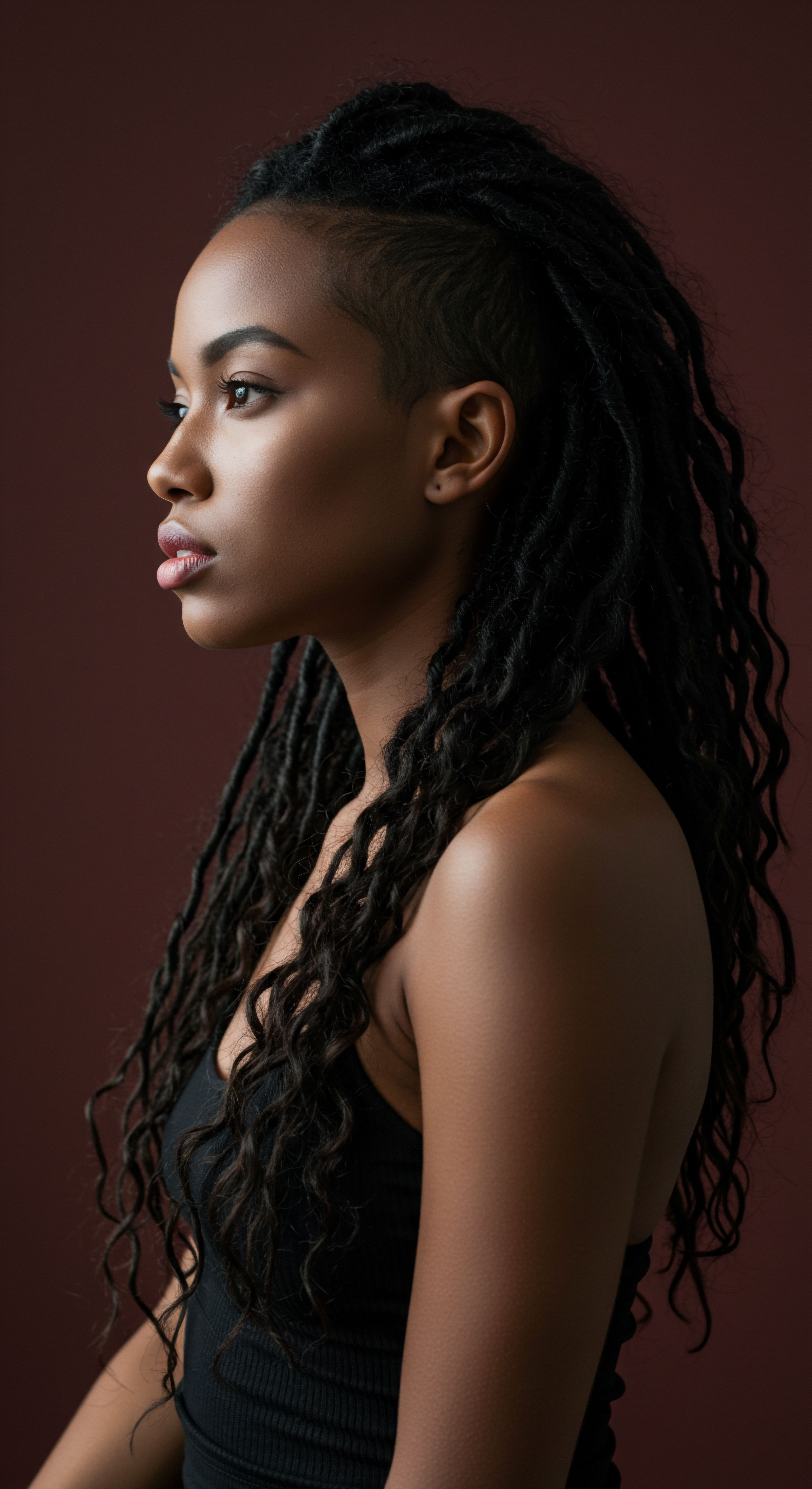
The Cultural and Historical Resonance
The concept of Restorative Slumber for textured hair is not a modern invention but a continuation of deeply rooted cultural practices. For generations, Black women have intuitively understood the vulnerability of their hair during sleep, employing head wraps, scarves, and bonnets as essential tools for protection and preservation. These practices, passed down through matriarchal lines, represent an ancestral wisdom that predates scientific validation, yet perfectly aligns with its findings.
The age-old practice of wrapping textured hair at night is a powerful, historically validated act of self-care, safeguarding moisture and structural integrity.
The historical significance of these rituals extends beyond practical hair care; they embody acts of self-love, identity preservation, and resilience in the face of societal pressures and hair discrimination. The intentional covering of hair before sleep, often accompanied by oiling and gentle manipulation, was a means of extending styles, minimizing the need for daily re-styling that could lead to damage, especially when access to specialized products was limited. This historical context lends a profound layer of meaning to Restorative Slumber, transforming it from a mere routine into a culturally significant act of care.
The deliberate choice of protective styling—be it braids, twists, or Bantu knots—before sleep, also carries historical weight. These styles were not only practical for managing hair during daily life but also served as a means of protection during periods of rest, keeping strands organized and minimizing environmental exposure. The longevity of these practices within Black communities speaks volumes about their efficacy and their enduring relevance in the pursuit of hair health.
The advanced interpretation of Restorative Slumber, therefore, integrates these threads ❉ the intricate biological processes of hair regeneration, the specific mechanical vulnerabilities of textured hair supported by compelling data, and the rich cultural legacy of protective nighttime rituals. This confluence of understanding empowers individuals with textured hair to approach their nightly care with informed intentionality, recognizing it as a pivotal opportunity for sustained hair vitality and a celebration of heritage.
The long-term consequences of consistently prioritizing Restorative Slumber are profound. They manifest not only in reduced breakage and enhanced moisture retention but also in improved hair density, increased shine, and a more robust overall hair appearance. From an expert perspective, this consistent, low-manipulation, high-protection approach minimizes cumulative damage, allowing hair to retain length and flourish. It becomes a strategic investment in the hair’s future, a testament to the power of thoughtful, continuous care.

Reflection
As we draw our exploration of Restorative Slumber to a close, a quiet understanding settles ❉ the journey of hair care, particularly for textured hair, is a continuous conversation between heritage, science, and the gentle rhythm of self-attention. This nightly embrace of repose is far more than a mere habit; it is a profound affirmation of our hair’s inherent beauty and delicate strength. Each intentional choice, from the soft whisper of silk against the scalp to the thoughtful placement of a protective style, becomes a tender act of preservation, safeguarding the legacy and vitality of every curl and coil. It is in these quiet moments of dedicated care that the true spirit of Roothea finds its most luminous expression, inviting us all to cherish the profound connection between our deepest rest and our hair’s most radiant bloom.

References
- DiStefano Hair Restoration Center. (2025). Does Sleep Affect Hair Health?
- Fashionista. (2024). How to Protect Curly and Coily Hair Overnight, According to Experts.
- UZIMA. (2023). Three Truths About Scalp Care for Textured Hair.
- India Today. (2025). 7 night haircare hacks to wake up with smooth, healthy hair.
- Pattern Beauty. (2022). Sleeping With Curly Hair ❉ 7 Tips For Preserving Curls Overnight.
- Capilclinic Blog. (n.d.). How does Insomnia affect hair?
- BijouxHair. (2024). Moisture Retention Hacks for Natural Hair Under a Weave ❉ A Complete Guide.
- Aveda. (n.d.). scalp solutions overnight scalp renewal serum.
- Good Rest Med Spa. (2024). Beauty Sleep ❉ Your Hair’s Secret Weapon.
- Nourished Springs. (2024). How does friction affect Afro textured hair?
- Scott J. (n.d.). A Curly Girl’s Guide to Healthy Hair ❉ Your Complete Scalp-to-Ends Care Routine.
- Dane County Department of Human Services. (n.d.). Afro-Beauty-Hair-Care-Booklet.pdf.
- NaturAll Club. (2020). How To Keep Your Hair Moisturized Overnight.
- American Occupational Therapy Association. (n.d.). AOTA’s Guide to Culturally Inclusive Hair Care Services and Incorporating Cultural Humility Into Practice.
- (n.d.). African American Skin and Hair Care ❉ Tips For Non-black Parents.
- British Association of Dermatologists. (n.d.). Caring for Afro-textured hair.
- L’Oréal Paris. (2022). How Does Lack of Sleep Affect Hair? An expert explains the relationship between sleep and healthy hair, plus hair growth.
- Sleep.com. (2021). How a Hair Wrap Routine Protects More Than Just My Hair.
- Shaz & Kiks. (2020). How Braids Protect Your Hair While You Sleep.
- HairMD Pune. (2023). Lack of Sleep Can Cause Hair Loss?
- (n.d.). How to Give Yourself Healthy Hair While You Sleep.
- Wimpole Clinic. (n.d.). Afro Hair ❉ Types, Haircare, Hair Loss Advice.
- Noma Sana. (2025). Understanding Hair Porosity ❉ What It Means for Your Textured Hair.
- scooms. (2024). Are silk pillowcases good for hair?
- (n.d.). The Importance of Good Sleep for Healthy Hair and Skin.
- Sew Historically. (2015). Night-Time Hair Routine – Victorian And Edwardian Hair Care.
- I Love Riccio. (n.d.). How not to damage curly hair at night.
- ELLE. (2020). A Brief History Of Black Hair Rituals.
- Medical News Today. (2020). Black hair care tips for washing, styling, and more.
- Katherine Haircare. (2022). Historical Hair Care Grew My Hair to Hip Length! Here’s How.
- Byrdie. (2025). Satin vs. Silk Pillowcases for Hair ❉ What’s the Difference?
- Wimpole Clinic. (n.d.). Silk Pillowcase Benefits For Your Hair & Skin.
- (n.d.). How Sleep Is Affecting Your Hair?
- Solsilk. (2024). Silk vs Cotton ❉ Why Silk Pillowcases are the Superior Choice for Restful Sleep.
- Ethical Bedding. (2023). Silk Pillowcase Buyers Guide.
- Women’s Health. (2018). ‘I Slept On A Silk Pillowcase For 2 Weeks—Here’s What Happened’.
- Slipssy. (2025). Slipssy’s First-Night Effect ❉ How Reducing Friction Transforms Your Hair Overnight.
- Sitting Pretty Halo Hair Extensions. (2022). 10 Protective Sleep Hairstyles For Better Hair.
- The Body Shop Australia. (n.d.). How to Sleep Better | Beauty Sleep.
- Anantara. (n.d.). SPA MENU.
- Afrocenchix. (2025). The Link Between Good Sleep and Great Hair ❉ Tips for World Sleep Day.
- Life Day Spa Fourways. (n.d.). Life Day Spa Fourways.
- Harper’s BAZAAR. (2023). The Texture Gap report into Type 4 textured hair explained.
- Cosmetics & Toiletries. (2020). Defying Damage ❉ Understanding Breakage in Afro-textured Hair.
- (n.d.). Historical Perspectives on Hair Care and Common Styling Practices in Black Women.
- MDPI. (n.d.). The Genomic Variation in Textured Hair ❉ Implications in Developing a Holistic Hair Care Routine.